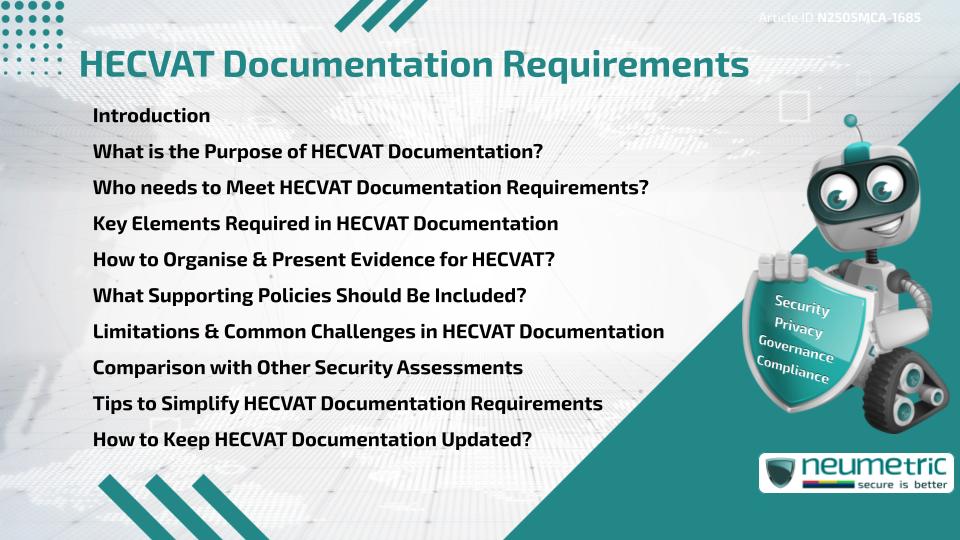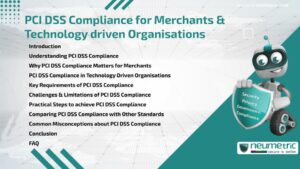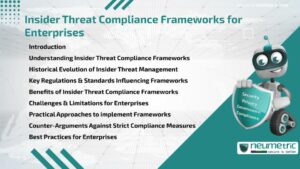Table of Contents
ToggleIntroduction
The Higher Education Community Vendor Assessment Toolkit [HECVAT] was developed to help Colleges & Universities evaluate the Cybersecurity Practices of Third Party Vendors. With many Institutions relying on Cloud & IT Services, Vendors are expected to meet specific HECVAT Documentation requirements to prove they handle Data securely & responsibly.
What is the Purpose of HECVAT Documentation?
HECVAT Documentation requirements ensure Vendors clearly explain their Security, Privacy & Risk Management Practices. This helps Academic Institutions avoid lengthy Audits while still gaining visibility into the Vendor’s Control Environment.
Who needs to Meet HECVAT Documentation Requirements?
Any Vendor offering Cloud-based or Digital Services to Higher Education Institutions may be asked to comply. This includes LMS integrations, SaaS Providers or Infrastructure Platforms that access Student or Faculty Data.
Key Elements Required in HECVAT Documentation
HECVAT Documentation requirements often include:
- Security & Privacy Policies
- Access Control Procedures
- Incident Response Plans
- Data Encryption & Disposal Methods
- Compliance Evidence for FERPA, HIPAA or Other Standards
Each response should include a description of the Policy & Supporting Evidence like Audit Reports or Screenshots.
How to Organise & Present Evidence for HECVAT?
Organise Documentation using clear Folder Structures—such as “Access Control” or “Incident Management”—to match HECVAT Sections. Reference Policies by consistent names & include relevant attachments. Use the HECVAT Lite or Full Version, depending on your Scope. Linking to updated Internal Documents can also streamline the Process.
What Supporting Policies Should Be Included?
To meet HECVAT Documentation requirements, include:
- Information Security Management System [ISMS]
- Business Continuity Plan
- Vendor Risk Management Policy
- Data Retention & Disposal Policy
- Accessibility Compliance Documentation
Up-to-date, Version-controlled Policies reflect a mature Security Posture.
Limitations & Common Challenges in HECVAT Documentation
Vendors may struggle with vague Documentation, outdated Policies or Lack of Ownership over Sections. Others find it difficult to balance Technical Language with clarity. Because the HECVAT is Self-assessed, Incomplete Responses may delay approval.
Comparison with Other Security Assessments
Unlike SOC 2, which is Third Party Audited, HECVAT relies on Vendor responses with supporting Evidence. While this reduces Audit Cost, it increases responsibility to provide accurate, clear Documentation.
Tips to Simplify HECVAT Documentation Requirements
- Reuse SOC 2 or ISO 27001 materials
- Assign internal Owners to each HECVAT section
- Maintain a shared Documentation Folder
- Review content Quarterly to avoid Expiration
- Ask Institutional reviewers for early Feedback
How to Keep HECVAT Documentation Updated?
Review HECVAT Documentation every six (6) months or after major Security changes. Use Tracking Tools or Document Logs to record updates. Version Control is key to ensuring consistency & accuracy in responses.
Takeaways
- HECVAT Documentation requirements support transparency between Vendors & Higher Education Institutions
- Responses should include both Policy Descriptions & Evidence
- Organisation, clarity & frequent updates are essential
- Aligning HECVAT efforts with other Frameworks can reduce duplication
- Regular review helps avoid rework & approval delays
FAQ
What does HECVAT stand for & Why is it used?
HECVAT stands for the Higher Education Community Vendor Assessment Toolkit. It helps schools evaluate Vendor Security & Privacy Practices.
Do all Vendors need to follow HECVAT Documentation requirements?
Yes, if they offer IT or Cloud Services to Institutions using HECVAT for Risk Assessments.
What Evidence is needed for HECVAT Documentation?
Evidence includes Policies, Reports, Security Controls & Compliance Proof for Standards like FERPA or HIPAA.
Can SOC 2 replace HECVAT?
No, but you can use a SOC 2 Report as part of your HECVAT Evidence.
How often should I update HECVAT Documentation?
Update at least every six (6) months or after major Security changes.
Is HECVAT used outside the United States?
Primarily in the U.S., but International Vendors may need to comply when working with American Institutions.
Need help?
Neumetric provides organisations the necessary help to achieve their Cybersecurity, Compliance, Governance, Privacy, Certifications & Pentesting goals.
Organisations & Businesses, specifically those which provide SaaS & AI Solutions, usually need a Cybersecurity Partner for meeting & maintaining the ongoing Security & Privacy needs & requirements of their Clients & Customers.
SOC 2, ISO 27001, ISO 42001, NIST, HIPAA, HECVAT, EU GDPR are some of the Frameworks that are served by Fusion – a centralised, automated, AI-enabled SaaS Solution created & managed by Neumetric.
Reach out to us!





